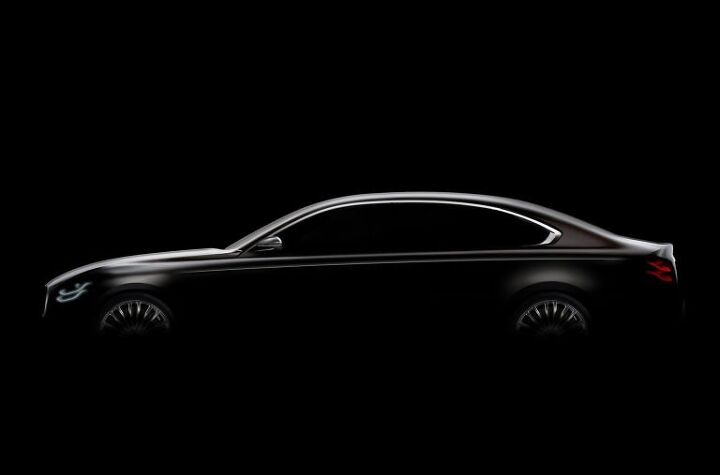2019 Kia K900 Plans to Do Something Its Predecessor Didn't - Find Buyers

The photo you see above is your first glimpse of the 2019 Kia K900 — the second generation of the Korean automaker’s full-size flagship sedan. If Kia’s lucky, it won’t be your last time seeing it.
Sold overseas as the K9 or Quoris, the first-gen model appeared on U.S. shores in early 2014 with Hyundai Equus underpinnings, rear-wheel motivation, a choice of V6 and V8 engine, and LeBron James as a spokesman. Sales crested the 2,500-unit mark in 2015 before falling to 455 in 2017. Like Bigfoot, the K900 is large and rarely spotted.
Kia hopes to change that with the new model.
Scheduled for a debut at either the Geneva Motor Show in March or the New York Auto Show in April, the 2019 K900 goes on sale in the second quarter of this year.
Boasting what Kia describes as “sophisticated exterior design, effortless performance and a spacious cabin distinguished by luxurious materials and elegant styling,” the next-gen K900 will add new driver assist features and comfort in an effort, like before, to position itself as a value leader in the luxury segment.
I’ve already stated why I feel a second-gen K900 is a pointless endeavor for Kia, at least in North America, so it’s not necessary to rekindle the argument.
As the Equus is long gone, new bones are in order, and the new K900 is expected to make use of the Genesis G90’s platform. There’s no reason why Kia wouldn’t borrow its powertrains, either. Having driven the G90, the Genesis’ attributes stand to correct the criticisms levelled at the previous K900: namely, numb steering and an overly soft ride. While still thin on the ground, the G90 felt perfectly refined, with a smooth, controlled ride and ample power from its 3.3-liter twin-turbocharged V6.
That engine makes a remarkably hushed 365 horsepower, 34 more than the first-gen K900’s 3.8-liter unit. Torque grows by 83 lb-ft to 376. A naturally aspirated 5.0-liter V8 makes 420 hp and 383 lb-ft, with both engines making use of an eight-speed automatic.
While the model’s long, high character line is similar to that of the G90, the pictured K900’s roofline is less formal, with a lower nose containing what we assume is corporate Kia grille. The taillights look like a mixture of Genesis and Mercedes-Benz.
While the new K900 seems like a great way to cannibalize G90 sales, Kia apparently feels it’s important to have a range-topping sedan positioned above the new-for 2018 Stinger. Two new rear-drive sedans from Kia in one year. The mind reels.
[Image: Kia Motors]

More by Steph Willems
Latest Car Reviews
Read moreLatest Product Reviews
Read moreRecent Comments
- Dwford Will we ever actually have autonomous vehicles? Right now we have limited consumer grade systems that require constant human attention, or we have commercial grade systems that still rely on remote operators and teams of chase vehicles. Aside from Tesla's FSD, all these systems work only in certain cities or highway routes. A common problem still remains: the system's ability to see and react correctly to obstacles. Until that is solved, count me out. Yes, I could also react incorrectly, but at least the is me taking my fate into my own hands, instead of me screaming in terror as the autonomous vehicles rams me into a parked semi
- Sayahh I do not know how my car will respond to the trolley problem, but I will be held liable whatever it chooses to do or not do. When technology has reached Star Trek's Data's level of intelligence, I will trust it, so long as it has a moral/ethic/empathy chip/subroutine; I would not trust his brother Lore driving/controlling my car. Until then, I will drive it myself until I no longer can, at which time I will call a friend, a cab or a ride-share service.
- Daniel J Cx-5 lol. It's why we have one. I love hybrids but the engine in the RAV4 is just loud and obnoxious when it fires up.
- Oberkanone CX-5 diesel.
- Oberkanone Autonomous cars are afraid of us.


































Comments
Join the conversation
VW Phaeton, Hyundai Genesis, Kia K900. What do they all have in common, besides being failures? Generally well reviewed sedans designed to compete with the big gun Germans, and costing thousands of dollars less, but sold at dealers with generally weak reputations for treating the customer well. You can easily take an upmarket brand down to the masses (see Packard, Cadillac, Lincoln, BMW, Mercedes as examples), but it is 1000 times more difficult to take a downmarket brand up to high society - especially sedans in an SUV/pickup market.
The K900 on the more modern G90 platform (which allows for AWD) should improve sales (maybe even up to around 2.5k - which was where the outgoing model did in its best year). Having the Stinger as a stablemate should help (just as the Genesis sedan served as a "bridge" to Equus sales).